Viewing: Blog Posts Tagged with: creative process, Most Recent at Top [Help]
Results 1 - 25 of 46
Blog: Picture Books & Pirouettes (Login to Add to MyJacketFlap)
JacketFlap tags: Inspiration, Creative Process, Faith, Hiking, Lauren Stringer, Mary Lyn Ray, Redwoods, Deer Dancer, Add a tag
Blog: OUPblog (Login to Add to MyJacketFlap)
JacketFlap tags: interviews, Journals, creative process, audio, production, recording, Oral History, budgets, transcription, *Featured, Oral History Review, Steven Sielaff, oral history interview, Add a tag
Throughout 2016 we’ve featured oral history #OriginStories – tales of how people from all walks of life found their way into the world of oral history and what keeps them going. Most recently, Steven Sielaff explained how oral history has enabled him to connect his love of technology and his desire to create history.
The post In the oral history toolbox appeared first on OUPblog.
Blog: Seize the Day (Login to Add to MyJacketFlap)
JacketFlap tags: Bloom, creative process, water, Add a tag
Hi folks, time for a new series! It's April. Time for water. Time for spring. Time for new beginnings. I will write about the water we need to burst with new life.
This week the post is really short but I hope helpful. What is water to my creative soul? Here is a simple list of stuff that makes me bloom.
1. A stroll on a sunny day.
2. A heartfelt conversation with a friend.
3. Kissing my sweetheart.
4. Hugging my purring cat.
5. Listening to an upbeat song.
6. Picking a bouquet of flowers.
7. Forgiving someone.
8. Seeing a need and meeting it.
9. Napping.
10. Stretching with breathing.
Ah, the best things in life are free. Something to remember when seeking water. I will be back next week with more water.
Here is a doodle.
Behold, my friends, the spring is come; the earth has gladly received the embraces of the sun, and we shall soon see the results of their love!Sitting Bull
Blog: Read Roger - The Horn Book editor's rants and raves (Login to Add to MyJacketFlap)
JacketFlap tags: creative process, NaNoWriMo, Out of the Box, Creating Books, Add a tag
 We’re a little over a week into National Novel Writing Month, and it seems an excellent time to let a few terrible secrets out of the box. For those curious outsiders, NaNoWriMo is a thirty-day writing challenge to produce a 50,000-word novel by 11:59 pm on November 30th. But when you’re writing, as those who are already knee-deep in their word counts can attest, NaNoWriMo feels more akin to a delicate balancing act undertaken while riding a rollercoaster during an earthquake. Which brings us to the secrets about this wonderfully ludicrous tradition:
We’re a little over a week into National Novel Writing Month, and it seems an excellent time to let a few terrible secrets out of the box. For those curious outsiders, NaNoWriMo is a thirty-day writing challenge to produce a 50,000-word novel by 11:59 pm on November 30th. But when you’re writing, as those who are already knee-deep in their word counts can attest, NaNoWriMo feels more akin to a delicate balancing act undertaken while riding a rollercoaster during an earthquake. Which brings us to the secrets about this wonderfully ludicrous tradition:
1. November is maybe the worst month for this.
Hey! You know that month when you spend weeks preparing to make, to help make, or to coordinate and eat a huge family dinner with several relatives you don’t see any other time of year (and with good reason)? That month when, if you’re in school, your life is reduced to weeks of studying, class reading, and paper-writing, punctuated by moments of sheer panic that you have no idea what you’re doing? That month when the midwinter holidays leer at you from the other side of a calendar-flip as if they know just how unready you are? What do they call that month?
That’s right: NaNoWriMo!
November is packed with end-of-year obligations, distractions, and, frankly, totally legitimate excuses for giving up on trying to writing a whole novel in thirty days. And that, oddly enough, is something like the point. Any month in any year in any stage of your life will be full of distractions and excuses, and waiting for the perfect downtime to start writing will only make you extremely good at waiting. Writing when it is inconvenient, disruptive, and downright impossible is something all writers must do, and November is as good a time as any to learn how.
2. Be prepared to hate everything.
And I mean everything.
- The friends, loved ones, strangers, and Google searches that informed you of NaNoWriMo’s existence.
- The friends, loved ones, strangers, and Google searches that keep distracting you as you try to hit your daily word count.
- The word count! (a.k.a. “your new measure of self-worth”)
- The English language, which utterly abandons you by Day 10.
- Your computer and its terrifying game of “Do you want to save those changes you don’t remember making?”
- The need to eat or to sleep.
- And of course, almost every word of your NaNo novel. (Except for those one or two perfect sentences — you know the ones I mean.)
Just bear in mind that NaNoWriMo is thirty days of the creative writing process hurtling towards the ground at terminal velocity while on fire — feelings (negative and positive) are inevitable. Happily, with NaNoWriMo, you have a supportive, national community of other writers going through the same process. The other good news? A little (or a lot) of emotional turmoil is a sign that you’re invested in your narrative. And investment is the difference between writing it and giving it up.
3. You may not hit 50K words.
But…then what was the point?
You can take it from me, a reasonably together human being who has battled this beast on four different occasions and never won — sometimes you don’t make it to 50,000 words. And that is a beautiful thing.
NaNoWriMo is like sprinting through a marathon — a marathon where your goal is not just to reach a finish line, but to shape something interesting with your footprints as you run. It is a thirty-day challenge to put words and narrative events in some semblance of order, to turn off (or to at least dial down) the internal editor that wants you to keep looking backwards, and perhaps most importantly, to shove past the paralyzing fear of the blank page in front of you. The finish line — that 50,000 word count — is a lovely thing, but you’ll find that reaching it or not reaching it has very little effect on the story that you’ll have actually created.
Remember, remember that in the month of November, NaNoWriMo is exhausting, thrilling, terrifying, entertaining, ridiculous, and amazing. If you’re thinking about participating, try taking a test run during Camp NaNoWriMo in April and July before officially participating in November. And if you’re already participating this year, remember that you’re writing because you want to, which is one of the coolest things you can do with any thirty days.
Now, stop procrastinating, and good luck!
For more NaNoWriMo, look for write-ins and workshops on our events calendar, then check out our silly series of #DinoWriMo puns.
The post 3 terrible truths about NaNoWriMo (that prove you should absolutely do it) appeared first on The Horn Book.
Blog: Design of the Picture Book (Login to Add to MyJacketFlap)
JacketFlap tags: everything you need for a treehouse, storytelling, creative process, pacing, composition, white space, flying eye books, emily hughes, Add a tag
I can’t stop thinking about the line Emily left us with yesterday, this one:
They are stories coming from a place of trying to understand, rather than a place where it is understood.
Right?
Welcome back, Emily! Hope you enjoy the rest of our conversation. (And a reminder, click to enlarge any images.)
Can you tell us about the design of the art and the text? I love that your pictures don’t have text on them anywhere, and the page turn with the flower is the only time there’s text away from the bottom. What went into those decisions?
There wasn’t much decision making- that was the problem! Often times I like to work with only a bit of text because type is a whole other ball-park in terms of aesthetics. I have a hard time compromising my space for words- text and fonts and size, all that jazz has to mesh in with the artwork, and it’s hard finding the right voice to match the looks.
My work gets pretty dense, so I find it a lot more difficult to find something that is legible, but still yields to the art. In university I preferred to keep my lines simple and punchy and give a whole page of text to one image- it makes you read everything slower, more thoughtfully. However in the world of big print-run publishing, it is a luxury to use up so much paper! I work on the pacing, but the designers at Flying Eye made a lot of the technical decisions and all the book designing- I think they’ve done beautifully.
What is your favorite piece of art hanging in your home or studio?
I work at home, and my favourite art piece is this ceramic self-portrait bust my Dad made when he was a kid in school. It’s got hair that looks like it was squeezed through a garlic presser- he forgot a bit of hair on the back though, and he made his nostrils with a pencil eraser. It’s a bit creepy, bit primitive cool. Very seventies. Still trying to find the best place to display it.
What are some of your favorite picture books? Both for writing and text and whatever inspires? What is your favorite picture book from childhood?
My favourite old school book is Munro Leaf’s Ferdinand. It is a beauty in text and image- what a fantastic story about the happily peaceful bull. Didn’t want to fight, didn’t want the fame, just wanted the simple pleasures of everyday life. You come across the message of being unique quite a bit in children’s books. Oftentimes it’s a feeling of ‘you’re different’ therefore special, therefore better. I don’t get that passive aggression or hypocrisy with Ferdinand.
For modern, I love Michael Rosen/Quentin Blake’s Sad Book. It isn’t sappy or over the top, it is perfect. No melodrama or silver-linings, just honest. The book feels like it is quietly listening to it’s readers own blues. It brought me real comfort. It is really a gem.
In terms of illustration, I love everything that is Blair Lent. Dreamy.
What’s next for you?
Lots of good things in store at the moment! I have finished a bunch of projects recently, and am still catching my breath.
I just finished A Brave Bear with Walker Books, and Brilliant with Abrams, and I’m now moving on to a book series with Chronicle for easy readers called Charlie and Mouse which is written by Laurel Snyder.
Oh, and did I mention the ever lovely Everything you Need for a Treehouse by THE Carter Higgins? I am excited about it all, and slowly getting better at juggling everything- at the moment I am trying to doodle personal work (if you don’t maintain this, everything goes bad, you don’t evolve!), little brothers, and treehouses. For boys, I’ve been creeping around my high street and local parks to get inspiration, for tree houses I fondly think of the ones my neighbours and I repeatedly built unsuccessfully. Now I can build one without the necessary requirements of having lumber readily available, knowing how to saw wood, and basic physics!
Exciting, busy, new!
—
Thanks, Emily! It was such an honor to have you here, and I am so, so excited about our future!
Huge thanks to both Emily and Tucker Stone at Flying Eye Books for the images in this post!
Add a CommentBlog: Design of the Picture Book (Login to Add to MyJacketFlap)
JacketFlap tags: interview, storytelling, Uncategorized, creative process, balance, pacing, composition, perspective, color palette, white space, emily hughes, everything you need for a treehouse, flying eye, Add a tag
 by Emily Hughes (Flying Eye Books, 2015)
by Emily Hughes (Flying Eye Books, 2015)
Friends, I am beyond awe with this conversation with Emily Hughes. If you aren’t familiar with her work yet, I guarantee you will fall in love with it, with her, with a storytelling brilliance that is out of this world. Here, she lets us know both where stories come from and why they do.
And a note, you’ll definitely want to click on all of these images to enjoy them at their full resolution.
Enjoy!

 Can you talk about where this book came from? And what the process was like for its creation?
Can you talk about where this book came from? And what the process was like for its creation?
Lots of things were swimming around in my head when The Little Gardener was being made. I was back home rereading a book I love, The Growth of the Soil, about a simple self-sufficient man dealing with societal pressures that seem unnecessary. He was the symbol of The Little Gardener, he’s not the personality powerhouse Wild is, he is really just a symbol for the everyman, the underdog, you, me, (my brother thinks the 3rd world) our place as a human. It’s not about him, it’s about his vision, his hopes.
There are a lot more nuances to that, but that is what it is in a very small nutshell. The process for Gardener was an outpouring, I drew and drew and drew. Because the images are so dense it was a meditative book to make- almost like making a mandala. The story process took a while, but with the images I worked on steadily through, and luckily they worked out with little drafting. That isn’t the usual, but this one felt natural to make, intuitive.
Why do you think your stories are best suited to the form of the picture book? What can you do in this form that you might not be able to in another?
If you look at my bedroom, my backpack, my email inbox, my general manner, you would be able to figure out a good deal about me. Totally scatter-brained.
It is an affliction that makes it tricky to get work done in general. What makes children’s books an appealing medium for me is that there is text to dance with. There is the written skeleton to adhere to- oftentimes my stories have layers that I have built up depending on where I am or what I’ve been thinking of while I work. There is not just one story being told in The Little Gardener. Having text keeps my brain focused when there are other ideas floating about. Because I also draw, I am able to tell the other story lines as well- they are quieter, but are still present for others to interpret if they have patience. It is a good compromise for me.
Narrative has always been an interest, I think telling stories is what I like to do- so the things I’d compare it to would be film, theater, animation, etc. I like doing illustrations for picture books because it’s 2D and doesn’t move. However, if you are really invested you can move them within your head and expand it’s boundaries to a world you truly are interacting with.
One of my favorite things is the cola can that says MADE IN HILO, HI on it. I know that’s where your roots are, and I wonder how that home has shown up in the work that you do? Or if there are other easter-egg-y things that you stick in your work?
Good spotting! Hawaii is always present in my work. I left home for university in England when I was 17, and at that time I was eager for new experiences. Nevertheless, absence makes the heart grow fonder, and I miss the Big Island always. Drawing things from home is indulgent for me- it is time spent reminiscing, it is a means for me to keep connected, grounded.
The cola can was initially modelled after a local company- Hawaiian Sun. The label looks nothing like the original (and I used the non-existent ‘cola’ because I thought it would be easier to translate), but the sun made a symbolic appearance. Those cans are always around- refreshments after soccer games, trips to the beach, the park with cousins. It reminds me of happy outings. I’ll add this bit to my advertising resume…
The house that the humans live in is based on my family home. It’s a plantation-style house that my Grandmother grew up in, as my siblings and I have also done. It’s a special place.
In the scene where the gardener is chasing away the snails, there’s a ‘rubber slipper’ (you guys would call it ‘flip flop’- Hawaii’s preferred footwear of choice) strewn about. It even has the ‘Locals’ tag on it which is the same kind you get at the grocery store. There’s lots of little things from home hidden. I like having the sentimentality there, even if it’s for my own benefit.
It seems like the girl in Wild and this little gardener have some sensibilities in common, like the hope and comfort in this un-tapped-into nature. Are there big-picture-stories you are drawn to creating, both in text and in art?
There are a lot of stories I’d like to tell. I think I start off with a general character and theme and it evolves- the writing is the last part, I think the feeling needs to be understood first. In my journal these are a few themes I’d written that I want to explore:
Does ‘evil’ exist? Really?
You can, will, should feel every horrible emotion and that’s fine
Kindness trumps all
Looks vs Expectations
It’s all chance for me I think- I might read something, or watch something, or sit blankly staring at the wall even, and most times it is nothing but a murmur. But once in a good while something speaks up.
As for Wild and Gardener, nature serves as a backdrop because it is an ideal to be in sync within our most natural of habitats. Something we all still strive for- a place where we’re needed. Wild is about acceptance and tolerance, issues I was trying to practice myself. Gardener was about keeping hope alive when I was faltering with my own.
They are stories coming from a place of trying to understand, rather than a place where it is understood.
—
Carter, here.
You guys. I keep reading these answers over and over and feel like it’s such a gift to get this glimpse into a storyteller’s heart. Because Emily is fascinating and brilliant and our conversation gave me so much to wrestle with and enjoy, there’s more! Come back tomorrow for the second part. More pictures, more process, more book love.
Whatever you do, get your hands on this book as soon as you can, for hope and home and heart.
Huge thanks to both Emily and Tucker Stone at Flying Eye Books for the images in this post!
Add a CommentBlog: Seize the Day (Login to Add to MyJacketFlap)
JacketFlap tags: Bloom, creative process, Add a tag
Hi folks, last post in the BLOOM series. Flooding has inundated Texas this month. I drove by the Navasota River yesterday, and it was at least a mile out of its banks. I mean when it rains here it makes Seattle look like the sunshine city. My youngest nephew is spending the week with me because his house was flooded in Houston. I have been a busy bee.
It's a feast or famine situation in Texas. I have lived here for five years. Four of those years have been drought years. And finally we hit this year. Yes, everything is blooming that isn't drowning. My red daylily is just popping velvety bloom after velvety bloom, the first year that has happened since I planted them. I want that for my writing life.
Wait for your flood year. Life has a way of not clopping along at an even pace. This drives me crazy because I like a nice even pace. I have had some dry years in a row. I have big expectations of myself. I want to rattle the cages and shake the foundations worldwide. This is tough to do in the middle of a California drought. I am working toward good climate change.
What can I do to bring water to my work? I plan to teach students how publishing works with my upcoming summer in my program at the local RINGER Library. TeensPUBLISH for 7th through 12th graders. Wednesdays in June and July except July 1.Time: 2:30 to 5:00. For more info about this event and registration info, please follow this link. A creative experience like this will bring in some rain.
What else will I do? I'll convince you to check out my awesome book PLUMB CRAZY too! Here is a link to purchase it. There is a lot of my heart on these pages. You might find a bit of your heart there too. I am always finding myself within the pages of a book. You need that!
So what to do while I wait for the flood. I keep working. I hope you do too! You are not alone, and the creative journey is worth it. I will be back next week with a summer series that is all about the journey to publishable works. I hope you hang out for that. :) Enjoy the sunshine when you can find it. Seize the day!
Here is a doodle for your life. "Fire Sky"
Here is a quote for pocket.
Do not spoil what you have by desiring what you have not; remember that what you now have was once among the things you only hoped for. Epicurus
Blog: Adventures at Wilder Farm (Login to Add to MyJacketFlap)
JacketFlap tags: Creative Process, sketchbook, Lita's Entries, Add a tag
It is always so inspiring when I get to step out of the studio and work in the field with sketchbook in hand. My most recent painting trip was in France.

My goal was to gather ideas for a book I am just starting that is set in France, but even more importantly, to take some time away from the intense studio work and create an atmosphere of creative play and exploration. I want to see and record as much as I can when I am working in a sketchbook. But I also want to stretch myself as an artist, try new methods, experiment with new surfaces, tackle paintings I would never do in the studio, basically just climb out on a limb and PAINT. On this trip I painted in gardens and on street corners, I painted rooftops and sculptures, I even painted self portraits of myself because I wanted to record how happy I was while exploring. I worked in ink and watercolor, fountain pen and pencil. I had fun collecting bags from Paris shops and experimented with watercolor on toned surfaces. The warm brown paper bags made a wonderful surface to bounce the blue skies and dazzling light of Paris. Sketch trips are always a wonderful time to really push yourself to see new things and play with ideas on how to capture them in paint. I always feel thankful after painting trips and even a little reluctant to give up the freedom I find in the field as apposed to the studio. But journeys with sketchbooks always recharge me and fuel my ideas for stories. They make the work I create in the studio all the more meaningful because the work was started during such joyful adventures.
Here are a few of the sketches from this last trip.

Amboise, France

Amboise, France

Amboise, France

Degas bather, Musee d'Orsay

Rodin, Gates of Hell, Musee d'Orsay

Iranian pot, Louvre

Mesopotamian Stone, Louvre

Notre Dame, Paris

Notre Dame, Paris

Paris, night scene

Notre Dame, Paris

The Burghers of Calais, Rodin Museum

Tours, France

Villandry, Loire

Villandry, Loire
The post Creative Play appeared first on Lita Judge.
Blog: Adventures at Wilder Farm (Login to Add to MyJacketFlap)
JacketFlap tags: Lita's Entries, Creative Process, Add a tag
Creating is such a leap of faith for me. Today I'm channeling all the art totems and spirits I hold close as I forge deeper into a project that is scary, thrilling and exquisitely exciting. Not ready to post sketches of it.... but soon.

The post Creating appeared first on Lita Judge.
Blog: From the Mixed-Up Files of Jennifer Bertman (Login to Add to MyJacketFlap)
JacketFlap tags: creative spaces, Pat Zietlow Miller, Wherever You Go, Eliza Wheeler, Sophie's Squash, picture books, creative process, Add a tag
 And fortunately for the children's book world, Pat has more books coming out in the world--SEVEN to be exact (at last count). Coming in April is Wherever You Go, illustrated by Eliza Wheeler. In Wherever You Go, join an adventurous rabbit and his animal friends as they journey over steep mountain peaks, through bustling cityscapes, and down long, winding roads to discover the magical worlds that await them just outside their doors. This book celebrates the possibilities that lie beyond the next bend in the road – the same road that will always lead you home again. Kirkus Reviews gave Wherever You Go a starred review with the praise: "Miller's verse, infused with musical momentum, communicates the emotional arch of a journey with beautiful brevity."
And fortunately for the children's book world, Pat has more books coming out in the world--SEVEN to be exact (at last count). Coming in April is Wherever You Go, illustrated by Eliza Wheeler. In Wherever You Go, join an adventurous rabbit and his animal friends as they journey over steep mountain peaks, through bustling cityscapes, and down long, winding roads to discover the magical worlds that await them just outside their doors. This book celebrates the possibilities that lie beyond the next bend in the road – the same road that will always lead you home again. Kirkus Reviews gave Wherever You Go a starred review with the praise: "Miller's verse, infused with musical momentum, communicates the emotional arch of a journey with beautiful brevity."To learn more about Pat Zietlow Miller, visit her website.
Describe your workspace.
- A dictionary and bookmark I got from my high school English teacher Gladys Veidemanis after I was voted “Most Likely to Be Published” by my classmates. It took more than 20 years after I graduated, but it did happen.
- A nameplate that belonged to my aunt, Faye Clow, who was director of the Bettendorf Public Library for many years. She was a huge proponent of books and literacy, and I always loved her and admired that. My upcoming book, Sophie's Seeds (Schwartz & Wade, 2016), is dedicated to Faye.
- The F&G [publishing term that means folded and gathered--they are fancy colored proofs] of whatever my next book is. Right now, I have Wherever You Go, which is coming from Little, Brown on April 21 and Sharing the Bread, which is coming from Schwartz & Wade on Aug. 25. Getting the F&Gs always makes the book finally seem real.
Blog: A. PLAYWRIGHT'S RAMBLINGS (Login to Add to MyJacketFlap)
JacketFlap tags: creative process, entertainment, playwright, plays, playwriting, on writing plays, play progress update, play submissions, Add a tag
Thought I'd share some thoughts about submission - of the literary type. As is the case with most playwrights, I'm continually searching the web for possible good fits for my literary babies. They really are like babies given the attention, work and copious amounts of love that go into their creation. As is the case with offspring who reach maturity, there is a point where one has to part with them for their own good - and mine.
Progress has been achieved in the submission process including a rejection letter accompanied by a wonderful critique and evaluation of the submitted play. Theatres that are open to unsolicited submissions must be the recipients of thousands of plays and understandably, responding to playwrights individually isn't practical. It's commendable, therefore, when a theatre takes the time to not only respond to a play submission but actually take the time in writing to point out the plays strengths and weaknesses and make suggestions as to changes that would strengthen the overall story line. Let's say that it was one of the nicest rejections received to date.
Some of my other plays were sent packing to try their luck and as yet there has been no response. As if the playwriting process isn't difficult enough, the waiting period to hear back one way or the other is equally if not more stressful. Frequently, there is no response, which in itself is an indication of their fate.
I'm now taking precautions to e-mail my plays to myself before sending them out to ensure that it is in a readable format for the recipients. This move came about after encountering a problem submitting a play electronically when converting one of the older files to the latest version. Checking to ensure the play was successfully sent, somehow the text ended up in the wrong visual format. After a period of ranting and raving and some hair pulling, literally and figuratively, I decided to re-send in spite of a nagging, internal voice telling me to hold off for a bit. Re-sent it, anyway, accompanied by a two-sentence explanation only to discover the next day upon re-examination that the text somehow had adjusted itself and was visually perfect. Also re-confirmed my belief to always heed that inner voice.
While waiting for news, I'm continuing working on "Dead Writes", a fantasy with some comedic tones combined with interesting moral messages and dilemmas for the characters. Definitely a challenge but one worth meeting. Then again, the act of writing plays is always a challenge, no matter what.
When asked the question of the time it takes to complete a play, I quote the line expressed by Edward Albee: "People often ask me how long it takes me to write a play, and I tell them 'all my life." And then some.
Blog: From the Mixed-Up Files of Jennifer Bertman (Login to Add to MyJacketFlap)
JacketFlap tags: creative process, Scholastic, creative spaces, Dan Gemeinhart, The Honest Truth, Add a tag
In all the ways that matter, Mark is a normal kid. He’s got a dog named Beau and a best friend, Jessie. He likes to take photos and write haiku poems in his notebook. He dreams of climbing a mountain one day.
But in one important way, Mark is not like other kids at all. Mark is sick. The kind of sick that means hospitals. And treatments. The kind of sick some people never get better from.
So Mark runs away. He leaves home with his camera, his notebook, his dog, and a plan. A plan to reach the top of Mount Rainier. Even if it’s the last thing he ever does.
A bit of both! When I start writing a book I tend to know most of the first third of the story, and most of the last third. There are holes here and there, and the entire middle is kind of a mystery, but as I write through that first third it starts to kind of gel and develop some gravity and momentum and then it fills in as I go. There are surprises every time, though. As much as I'd like to and as hard as I try, I just really struggle to do much pre-outlining. I just stare at the paper and my brain says, “How the hell should I know what happens next? I haven't started writing the story yet!” I wish I could outline, because I think it's better practice; I think I'd have to do less revising if I could do more planning ahead on the rough draft.
Blog: From the Mixed-Up Files of Jennifer Bertman (Login to Add to MyJacketFlap)
JacketFlap tags: Conspiracy of Us, Maggie Hall, creative process, creative spaces, YA, Add a tag
To fight her destiny as the missing heir to a powerful and dangerous secret society, sixteen-year-old Avery West must solve an ancient puzzle in a deadly race across Europe. Forbidden love and code-breaking, masked balls and explosions, destiny and dark secrets collide in this romantic thriller, in the vein of a YA DaVinci Code.
Avery West's newfound family can shut down Prada at the Champs-Elysees when they want to shop in peace, and can just as easily order a bombing when they want to start a war.
They are part of a powerful and dangerous secret society called the Circle of Twelve, and Avery is their missing heir. If they discover who she is, some of them will want to use her as a pawn. Some will want her dead.
To thwart their plans, Avery must follow a trail of clues from the landmarks of Paris to the back alleys of Istanbul and through a web of ancient legends and lies. And unless she can stay one step ahead of beautiful, volatile Stellan, who knows she’s more than she seems, and can decide whether to trust mysterious, magnetic Jack, she may be doomed after all.
Blog: From the Mixed-Up Files of Jennifer Bertman (Login to Add to MyJacketFlap)
JacketFlap tags: Shallee McArthur, The Unhappening of Genesis Lee, writing, creative process, creative spaces, Sky Pony Press, Add a tag
Seventeen-year-old Genesis Lee has never forgotten anything. As one of the Mementi—a small group of genetically-enhanced humans—Gena remembers everything with the help of her Link bracelets, which preserve memories perfectly. But Links can be stolen, and six people have already lost their lives to a memory thief, including Gena’s best friend.
Anyone could be next.
Which is why Gena is less than pleased to meet a strange but charming boy named Kalan who claims that they’ve not only met, but that Gena knows who the thief is.
The problem is, Gena doesn’t remember Kalan, she doesn’t remember seeing the thief, and she doesn’t know why she’s forgetting things—or how much else she might forget. As growing tensions between Mementi and ordinary humans drive the city of Havendale into chaos, Gena and Kalan team up to search for the thief. And as Gena loses more memories, they realize they have to solve the mystery fast.
Because Gena’s life is unhappening around her.
1. My birds! Fred and George are zebra finches, and I LOVE those little guys. They actually are doctor-recommended therapy birds. I struggle with anxiety, but I also have multiple sclerosis, and side effects from anxiety meds don't work well for me with my MS. So my birds are there to help me through panic attacks and keep my general anxiety low. They actually help a lot more than I expected-- they are low-maintenance so they don't add to my anxiety, and their cheerful chirps and energy help reset my brain when it's anxious.
Um...no, actually, now that I think about it! I just open my laptop and get to work. :)
I don't like to listen while I work, but sometimes I listen to specific songs that fit the book I'm working on before I work.
None! It distracts me too much.
My freshman creative writing teacher in college told us there are only two things that matter in writing-- have a take, and don't suck. It reminds me that as long as I'm writing a story that's got my unique take on the world, and as long as I'm writing something that doesn't suck (which takes practice and a crit group!), that's all that matters. The millions of other "shoulds" and "shouldn'ts" about writing don't matter as long as I have a take and don't suck!
Blog: An Awfully Big Blog Adventure (Login to Add to MyJacketFlap)
JacketFlap tags: creativity, ideas, creative process, Becoming a Writer, meditating, Dorothea Brande, Heather Dyer, holding, Fearless Creating, hushing, Add a tag
One of the exercises that Maisel says is the most important in the whole book is the ability to ‘hush’ your mind. ‘Hushing’ says Maisel, ‘is what we do when we go into a museum and sit in front of one painting for fifteen minutes.’ Hushing is a ‘quieting and an opening’ – and there is no creative life without this ability to hush.
Blog: Here in the Bonny Glen (Login to Add to MyJacketFlap)
JacketFlap tags: Art, creative process, sketchbook, Ira Glass, Add a tag
I came across this Ira Glass quote (direct YouTube link for my iPad readers) and was struck by how accurately it describes my relationship to my drawing efforts.
“Nobody tells this to people who are beginners, I wish someone told me. All of us who do creative work, we get into it because we have good taste. But there is this gap. For the first couple years you make stuff, it’s just not that good. It’s trying to be good, it has potential, but it’s not. But your taste, the thing that got you into the game, is still killer. And your taste is why your work disappoints you. A lot of people never get past this phase, they quit. Most people I know who do interesting, creative work went through years of this. We know our work doesn’t have this special thing that we want it to have. We all go through this. And if you are just starting out or you are still in this phase, you gotta know its normal and the most important thing you can do is do a lot of work. Put yourself on a deadline so that every week you will finish one story. It is only by going through a volume of work that you will close that gap, and your work will be as good as your ambitions. And I took longer to figure out how to do this than anyone I’ve ever met. It’s gonna take awhile. It’s normal to take awhile. You’ve just gotta fight your way through.”
Such a good point. It’s because you can recognize what good art (writing, music, etc) is that you know yours isn’t good…yet. And so the daily habit becomes almost an imperative, if you want to improve. My writing is best when I’m writing every day. If I keep up the sketchbook habit for eight or nine years, I just might be able to draw the way I want to. ![]()
Not there yet.
Add a CommentBlog: Seize the Day (Login to Add to MyJacketFlap)
JacketFlap tags: mood, inspiration, muse, creative process, Add a tag
Hi folks, I've been pressured this week. I have a deadline looming. It's a few months off, but it mocks me from the distance. A ton of work is between me and that deadline. My creative self is just not happy being forced to perform. The writing is feeling very mechanical, and I've been feeling edgy. I can do the ton of work ahead, but I have to have an infusion of fun or this is going to be a dismal project.
As a professional writer, I don't have the luxury of waiting for a muse or finding the right mood. That said, without the muse or the mood, I struggle to get anything on the page that is infused with awesomeness. Without finding my groove, my work is painful and generally worthless and uninspired. To find my groove, I have to give myself time to play, a lot of time to play, This week I started up a project that is really for the fun of it. It's a silly project that is self-indulgent, silly, and sarcastic. No one wants this project. It's just for me. I delight in it.
Allowing myself to do something that lights me up, whether anyone else cares or not, fuels me with energy. The project has one targeted audience and that is myself. I am always working on projects like this. I doodle. I bake, I crochet, I knit, I sew, I sing, I play my flute, pluck on my dulcimer, weed my flowerbeds, chase with the cats or let them chase me, joke with my kids, write silly bits. I play. There are reasons for this creative play. One, I must be able to finish things because it makes me feel jazzed. Two, I must be free to complete something for my own self, something that sends a sense of accomplishment into my soul. Three, I get to call the flaws in my work character.
Play is like taking a tub of olive oil and tumping it on my head. It a lubricant that cuts down resistance. I jump into my work and slide forward with a rush of speed. I'm ungummed from the commercialization and commodifying of imagination. I find that sweet place of the song bird, croaking frog, or shimmering cicadas. I find what heart tells me to do. The dreaded deadline no longer looms. It's just a date on a calendar that happen to coincide with the marvelous creative journey I'm on. This dear readers, is the GROOVE.
I hope you have some fun and find your groove this week! I will be back with more musing next week.
Here is a doodle.
Here is a quote for your pocket.
Wrinkles should merely indicate where smiles have been. ~Mark Twain, Following the Equator
Blog: Seize the Day (Login to Add to MyJacketFlap)
JacketFlap tags: creative process, handwriting, Plumb Crazy Blog Tour, Add a tag
Hi folks, it is getting crazy hot here. Over a 100. Whew! Welcome to my little corner of the interwebs.
Did you know that PLUMB CRAZY is coming out in paperback? I'm celebrating! Enter to win the Plumb Crazy Book and Boots Giveaway. Book and $100 Gift Card to Cavenders:.tinyurl.com/mv2ku8y.
This week I offer a gem to help you with the creative process. I can't do all my work on the computer, Handwriting plays an important part in my creative process. I have to write the things by hand and don't expect something linear and neat. Expect bubbles with ideas, doodles of flowers and geometric shapes, half finished lists, freewrites, graphs, charts, me grousing about how hard it is to write books, pages of lame ideas, and lists of marketing ideas too.
I can't think any of this stuff on the computer, but I can think it on paper. I believe all this stuff happens in handwriting because I am bringing my style and individuality to the shape of the words. This added dimension opens wellsprings within. If you are struggling with moving forward with a creative project, grab a sheet of paper and a pen you really like and pour out your thoughts! You might be surprised.
I will continue this month with gems of creative wisdom. My doodle and quote are at the end. First a recap of the book tour!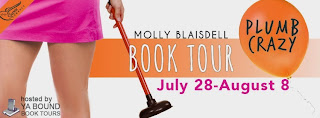
Plumb Crazy Book Tour Recap!
Fun stuff
The PLUMB CRAZY playlist - Victoria Simcox's Blog - http://ow.ly/zSdHS
You can listen to it on Youtube - http://ow.ly/zSdHS!
The Plumb Crazy Dream Cast! -The Avid Reader - http://ow.ly/zSgpj
Mitch's Profile! -- Book Club Sisters - http://ow.ly/zSf99
Mitch wins Book Boyfriend of the Week! - Book Boyfriend Reviews - http://ow.ly/zShqN
Wherein I Interview my character Mitch! - The Written Adventure - http://ow.ly/zSfS2
Author Interview! -- Kelly P's Blog - http://ow.ly/zSeo9
Wherein I share a true writer's journey - Writers' Connection - http://ow.ly/zSg7q
My Five Favorite Movies - My Love for Reading Keeps Growing - http://ow.ly/A8VxH
Tour Reviews
***** Review - Books Are Love -- http://ow.ly/A8YCc and http://ow.ly/A8Z0B
**** Review - Book Boyfriend - http://ow.ly/A8VSh
*** Review - Books, books, and more books - http://ow.ly/zSfEZ
Blog: Designing Fairy (Login to Add to MyJacketFlap)
JacketFlap tags: storytelling, creative process, creative inspiration, self care, whimsical illustration, being sensitive, spiritual lessons, teaching videos, artists and creative blocks, permission to create, why we don't create, Add a tag
I stopped making little films.
It hit me the other day when I felt the urge to make a little film for my social media client. The hunger to make one made itself known with familiar pangs and growls. It had been over a year since I gathered images and wrote a story and this confused me. Why did I stop?
Why do we stop doing what we love? “We lose permission” is the thought that came into my head when I asked this. When I was going to Grad School, I had permission and a structure which included definite expectations and assignments for the reward of a certificate. Most of these assignments involved making little videos to teach our message. I dove into the task with such lust that I knew this was my passion. I experimented with light animation, silly web shows, and personal stories in color pencil. I was always a storyteller, but now I had a vehicle that really matched me.
When school ended, I was left without permission. I needed to dive back into the work world and make money, and the films now seemed impractical. They needed to make a lot of money right away for them to be “worthwhile” and I didn’t know how. So I shut down that part of me.
A few months ago, I told a new friend what I did for a living. I hesitantly included creating little movies. “Oh, that’s a hobby then?” she said. I cringed down into the deep hollow of my stomach. “No,” I replied. “That’s my passion.” The words bursted out on their own before I could stuff them back in.
We stop painting, woodworking, writing songs. We stop crafting, jewelry-making, ceramics painting, doodling and drawing for fun. We become the “grown-ups” who are responsible, accountable, and serious, and if we have a teeny bit of time leftover, we let ourselves indulge. Many folks wait until they retire to have permission. All this withholding creates bitter, depressed, dried up people that take away the joy from the world.
Part of the creative process, whether by career or choice, is the PLAY stage. When scientists discover cures, they are first experimenting, which is their idea of playing. We experiment with tools, play, try out materials and techniques, and what comes out of that process can be very fruitful and helpful to others. When I made my FAIRY GUIDE I was playing in the garden. I wanted to learn about nature and healing. And what came out of those notes was a school that is over eight years old and international, and hopefully, helping many. Engaging in your creative passion is necessary. Nurturing your loves and where your creative impulses are taking you is following your intuition/gut, which is leading you to your greatest success (financially and/or emotionally) and where you need to be. It’s responsible.
I’m self-nurturing now by diving back into movie making. It feeds me like nothing else does. I feel filled up, joyful and 100% me. And it could lead to huge financial success in ways I haven’t even discovered yet, and/or it could just make me happy, and I deserve to be happy.
I give you permission to play, experiment, and dive down into your creative passion.
—————————————————————————————-
You might enjoy my upcoming Fairy Healing the Feminine (which talks about self nurturing) or Telling Your Story creative class which both start June 27th.
Blog: Adventures at Wilder Farm (Login to Add to MyJacketFlap)
JacketFlap tags: Creative Process, sketchbook, Lita's Entries, Add a tag
I spent Easter Sunday looking through old sketchbooks, dreaming about new ideas from old thoughts. I love sketchbooks – they have the ability to keep ideas and memories alive. I also find when creating them, I'm much braver while on an adventure than in my studio, to try different things. My journal is a place where I explore, and do a little re-inventing. Sometimes things just sit between the pages of a sketchbook forever, but occasionally they leap out a decade later and prompt a new story or direction in my work.
Here's an example of a painting I probably would never create in the studio, but it was just a moment of joy captured within the pages of my Paris journal. I passed this little dog each morning on my walk into the city. I thought he had both panache and whimsy so I played with a brightly colored sketch on the back of a little blue paper bag that held a scarf I had just purchased. It's fun to try new things.

The post Sketchbooks appeared first on Lita Judge.
Blog: A. PLAYWRIGHT'S RAMBLINGS (Login to Add to MyJacketFlap)
JacketFlap tags: writing, creative process, playwriting, new play, play update, on writing plays, Add a tag
As the title of the blog indicates, another day...another play almost finished. In playwriting 'almost' is a tricky term since endings are usually hard to come by.
"So give us an update on your playwriting efforts in general these days, Eleanor."
As mentioned ad nauseum here, finished "Old Soldiers" and entered it in this year's edition of the BBC International Playwriting Competition. Now comes the really hard part in waiting to hear back one way or the other. Being in this mental and physical state of being means a slight case of nausea when opening my e-mail in anticipation of receiving "the" word. Suffice it to say that waiting is not half the fun.
I'm "that" close to finishing my latest project, "Neighbors", which is turning into a great two-act play. As my mom used to say, "close" is only good when playing horse shoes. It had its origins as a short play and over the years as is my habit, it has been tweaked to death and sort-of atrophied in my filing (or none-filing) system. Recently, after reading it over for the zillionth time, I decided that it has the meat and bones (can a play have meat and bones one wonders...) for expansion. The story line, which is loosely based on facts, focuses on a row of shrubs that separate the back gardens of two neighbors, one of which believes that their placement encroaches on to his property. The end result is that it has caused a feud that has lingered and grown over the years. The dialogue is entertaining and the story is moving along to a natural conclusion, following which it will be put to bed for a while and re-read at a later date for changes. There are always changes in my world.
Interesting how the creative process works. As an artist in addition to being a writer, it seems that my best work is done at the cost of the other. To be more precise, when I'm in the midst of creating a new writing piece, my artistic output tapers off and vice-versa.
Meanwhile, I'm thinking about but not yet in the writing mode of my next play focusing on a young girl's experiences growing up after moving into a new neighborhood.. Not sure whether it will be a one act or full play but then I never know how it will work until consulting with the characters. Meanwhile, my blank canvases are calling me.
Blog: Darcy Pattison's Revision Notes (Login to Add to MyJacketFlap)
JacketFlap tags: photography, creative process, Ozark Mountains, photoessay, writing life, Add a tag
Goodreads Book Giveaway
Desert Baths
by Darcy Pattison
Giveaway ends November 10, 2012.
See the giveaway details at Goodreads.
What: A photography day-trip.
When: Saturday, October 13
Where: Glory Hole waterfall, Dismal Creek, Ozark Mountains of Arkansas
My husband, Dwight, is a photographer and he wanted to take a trip to the Ozarks this weekend to do some photography. This photo essay is about the creative process and how we can apply it to our writing process.
Plan for Creativity
Dwight planned this trip carefully. He had long wanted to see the Glory Hole waterfall. It’s a place where water has carved out an overhanging ledge, creating what is commonly called a rockhouse. But in the ceiling of this rockhouse was a five-foot hole. Normally the creek bed above fell through this Glory Hole into the cave created by the overhang. To get the right photo, we needed lots of rain to create a strong waterfall, and then, lots of sunlight to send a stream of light through that Glory Hole. It had rained Friday in the Ozarks and we hoped the trip would result in great photos.
Dwight planned for a waterfall shot; but he also brought along all his lenses and a tripod.
On the drive up Saturday morning, though, fog banks drifted over the Ozarks, at times limiting visibility to 100 feet. When we reached the parking for the Glory Hole hike, it was just a light fog. The guide book said that when we crossed a tributary to Dismal Creek, the water level here was a prediction of how well the waterfall would be running. And in spite of rain the day before and the current fog, there was only a trickle in the tiny creek.
Indeed, when we got to the Glory Hole, it was disappointing because the waterfall was a trickle and there was no sunlight to illuminate the water flowing into the cave below.
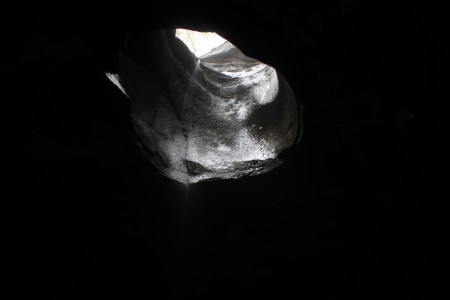
Glory Hole, Dismal Creek, Ozarks, as seen from below. Photo by Dwight Pattison, c. 2012 All Rights Reserved.
Turn Around
So, there we were a couple hours drive from home, an hour’s walk into the depths of the Ozarks–and conditions weren’t right. Fog obscured everything and the waterfall hadn’t cooperated.
But Dwight turned around and took this picture.
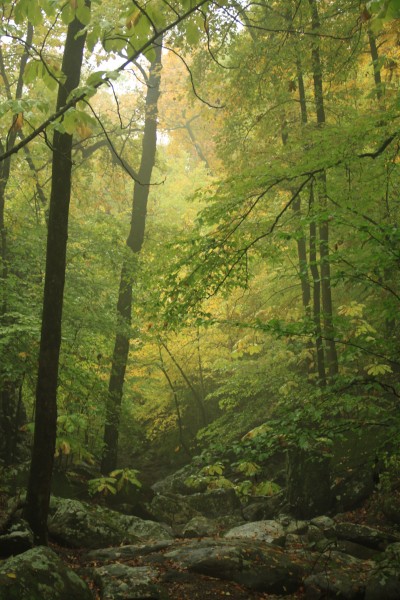
Looking down Dismal Creek from the Glory Hole. c. 2012 Dwight Pattison, All Rights Reserved. Click to see full size.
All it took was turning 180 degrees from where we stood. Sometimes, in the creative process, you just need to try the opposite of what you had intended.
Look Closely
Because Dwight had come prepared with all his lenses, we also stopped to look closely at what was around us. First, on the side of a tree was this snail. Dwight took out his close-up macro lens and the tripod to capture this snail in a larger than life-size photo. Likewise, we need to look deeply at our fictional subjects.
Then, I turned around and saw this tiny garter snake at my feet. You can guage his size from the leaves around him. This photo is about life-size.
Revise as Many Times as it Takes
Finally, walking back out, we stopped to photography some golden lichens. As I sat and watched Dwight make his photos, I noticed a funnel spider web. These webs are ground level, often around a lot of foliage. While the spider waits for a meal, it sits at the base of its funnel-shaped web. It’s a common sight in the Ozarks, but I had never actually seen a spider at the base of the web. This time, even with the naked eye, the spider was visible. Would the macro lens be able to capture it with any detail?
Dwight spent the next 15 minutes taking photos of the funnel spider. He took a shot, looked at it on the digital display, then made an adjustment: f-stop, exposure time, with a tripod, without a tripod, manual focusing, auto focusing. He bracketed shots, choosing a -1, 0 and +1 setting to get it right. Finally, after 15 minutes, he was moving the tripod and the camera slipped and frightened the spider and it disappeared.
In some of the shots, the water droplets were blurred to a foggy white web; in some, the spider wasn’t in focus. But in the end, he got this shot with each water drop (from the fog) clear and the spider as clear and in focus as he could make it. The spider’s hole was less than the size of a dime.
As writers, we also need to remember that it takes time to get it right and we need to be willing to experiment with our fiction–until we get it right!
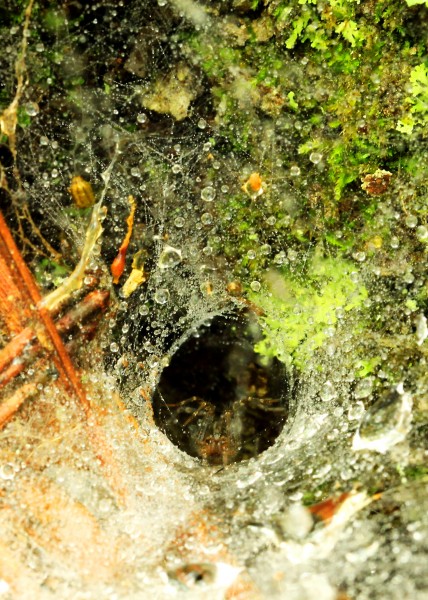
Funnel spider, Dismal Creek. c. 2012 Dwight Pattison, all rights reserved. Click to see it full size.
Final Edits can’t Correct Major Flaws
And finally, there were some minor edits when we got home on a photo-processing program. If the photos were already good, the final editing–minor corrections of color–would not have helped. Likewise, if the structure of our novels and stories isn’t right, an editor can’t help with minor edits. Take the time in the field–before you send in a story–to make it the best possible. Notice that there are only a few photos here, out of the dozens taken, that were deemed worthy of showing others. Here is the edited photo of Dismal Creek. The differences may be subtle to you, but to Dwight they are profound.
Photography–like writing–is a creative process. You may not get the shots you planned, but if you look around and take advantage of the situation, you’ll end up with something worth sharing.
Blog: Kat's Eye (Login to Add to MyJacketFlap)
JacketFlap tags: caregiving, trusting the process, publishing, creative process, caregivers, chicken soup for the soul, perseverance, Add a tag
Time and again, writers, editors and other folks in the industry say that if you want to be published, you should "Write what you know." So, in between Elena's first and second brain surgeries last year, I managed to sit butt in chair long enough to write a short story for an upcoming Chicken Soup for the Soul book. The beginning drafts were painful. I'd been away from the process for so long that slogging through my prose felt like an exercise in futility. But in the end, the hard work paid off. The Chicken Soup folks bought my story! Getting the news in the midst of our family drama was a highlight of my Year That Went to the Dogs, and a reminder to Trust the Process, wherever it takes you. Chicken Soup for the Soul: Family Caregivers hits bookshelves nationwide on March 13th. Check out this link for a look inside and to pre-order.
Blog: Tara Lazar (Login to Add to MyJacketFlap)
JacketFlap tags: CAVEMAN A B.C. STORY, Picture Books, Creative Process, Janee Trasler, PiBoIdMo 2011, Add a tag
 Generating ideas comes easily for me. I am participating in my own private PiBoIdMo every day of the year. I jot down ideas on napkins; I write them on my hand; I email them to myself; I leave myself idea voice mails. I’ve got no problem with ideas.
Generating ideas comes easily for me. I am participating in my own private PiBoIdMo every day of the year. I jot down ideas on napkins; I write them on my hand; I email them to myself; I leave myself idea voice mails. I’ve got no problem with ideas.
It’s getting those ideas out of my head and onto paper I struggle with.
You’ve probably met people who get an idea on Monday and by Wednesday, have a polished, publishable, picture book manuscript ready to send, right? I’m in a critique group with those people.
I am not one of them.

My process looks something like this.
- Get brilliant idea.
- Decide that I am a genius.
- Jot down a few notes.
- Let idea brew.
- Critique way too early in process.
- Decide that I am not a genius.
- Decide, in fact, that I suck.
- Stuff notes in deepest, darkest corner of drawer.
- Get sudden inspiration while washing dishes.
- Pull notes out of drawer.
- Reread notes.
- Decide that I am genius after all.
- Jot down new inspiration.
- Let brew.
- Make storyboard.
- Revise storyboard 42 times.
- Write first draft.
- Send to critique group.
- Wait for them to confirm genius.
- Get feedback from critique group.
- Decide that critique group doesn’t know what they’re talking about.
- Stew.
- Decide that critique group is genius after all.
- Revise.
- Send to agent.
- Wait for her to confirm genius.
I could probably trim a lot of self bashing and praising from my process, but the other parts, the brewing, story boarding, and revising are really important for me. I get an idea and actively brainstorm it for a bit, but then I need to put it away and let my subconscious work on it.
It gives my idea time to grow. It allows me to make connections I might not have otherwise made.
I used to think of this as a bad thing. I compared myself to the idea-on-Monday-polished-draft-on-Wednesday people and felt lesser, but then realized it’s just the way I work. The time I spend brewing my idea, they often spend looking for one.
The other part of my process that I’d be loath to lose is the storyboarding phase. I get a lot of the kinks worked out here before it ever goes to draft form. I number a piece of paper 1 through 15 to represent picture book spreads. I tentatively write the exposition on the first line and the resolution on line 14. I pace out the major plot points on lines 2 through 13 and the wrap up on line 15.
As I’m playing with the storyboard, I know I’ve got the half-title spread to steal if I really need an extra spread to complete my arc.
I find it so much easier to revise the storyboard than a draft, that I will try things here that I might not try if I went straight from notes to writing. There’s a lot less risk to trying something at this stage.
I congratulate you all for participating in PiBoIdMo, and whether it’s ready next Wednesday or three years from now, I look forward to adding your picture books to my collection!
 Janee Trasler has illustrated 19 books and written/illustrated four of her own. Her latest book,
Janee Trasler has illustrated 19 books and written/illustrated four of her own. Her latest book,
Blog: Blue Rose Girls (Login to Add to MyJacketFlap)
JacketFlap tags: creative process, Add a tag
Last weekend, Grace suggested that I write a non-fiction book about _________________,* a topic that's long been dear to my heart. I was really excited and when I got home, instead of taking my usual time to re-adjust after having been away, I got started. I finished a rough draft in one day.
Why hadn't *I* thought of writing this book? I don't know....maybe some of us don't know ourselves that well, or maybe some things are so obvious we don't think of them. I don't know and it doesn't matter.
The point is, sometimes other people do know best. These books were ALL suggested by editors:
Grace has told the story of how she sent some illustrations to a publisher, and he wrote book asking if she had a story to go with them -- the result was THE UGLY VEGETABLES.
A publisher suggested that Louisa May Alcott, who up to that point had been writing trashy melodramas for adults, write a story for girls. She did -- the bachelor publisher to whom she sent it (maybe not the same one?) found it incredibly boring, and was going to reject it....until he came downstairs to find his ten-year old niece sobbing over the ms. (LITTLE WOMEN).
One of my childhood favorites, THE TREASURE SEEKERS came into being when an editor asked E.Nesbit to write a story about her schooldays....she did, and that led to THE TREASURE SEEKERS, which was first published in PUNCH. People weren't sure if it was for adults or children, but they finally decided -- kids, and it came out in book form around 1900. It hasn't been out of print since. HARRIET THE SPY was suggested by the great Ursula Nordstrom.
I'm not saying my book is at this level -- I should be so lucky! But it IS interesting, how sometimes other people (especially good editors) know us and our talents better than we know ourselves.
Of course, not all editorial suggestions are good ones. When I'm the editor, I tell my clients that if (after I've explained what I mean as clearly and forcefully as I can), they think about it and decide I'm wrong -- I AM wrong. Whether I'm the author or someone else is: we, the authors, always know the truth, even if it's bured under the excuse that we're just being too hard on ourselves (or whatever). We really do know. But sometimes we can't see it until someone else says it.
If someone makes a suggestion and I instantly agree with it and get excited about it, SHE'S RIGHT.
View Next 20 Posts





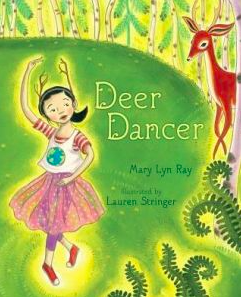














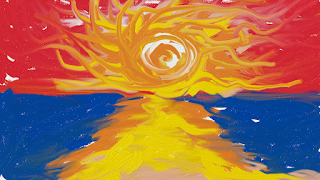









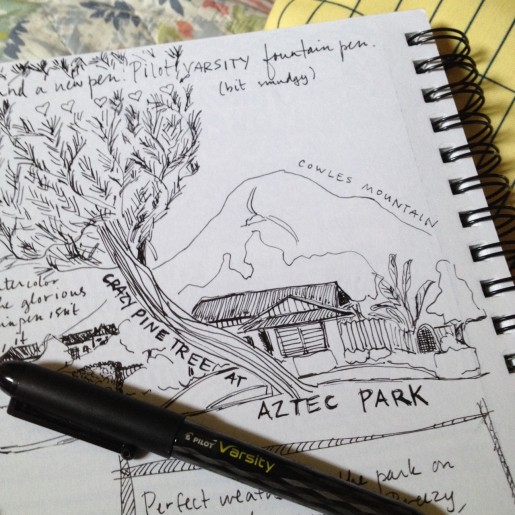


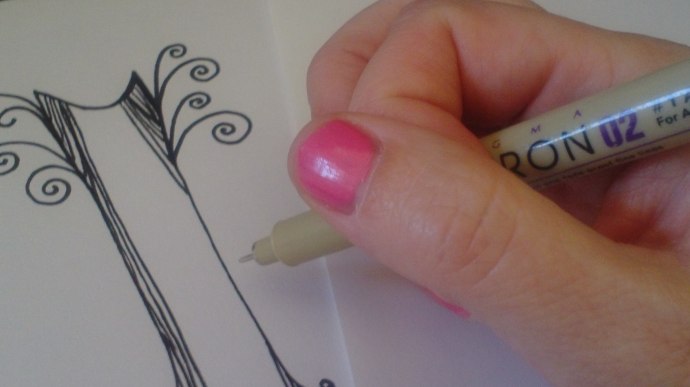




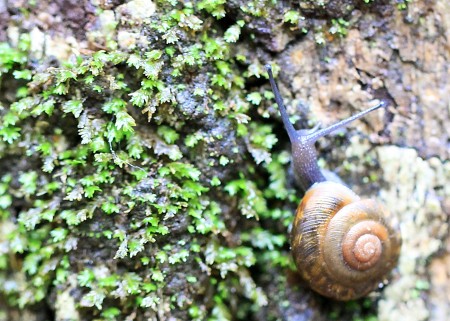
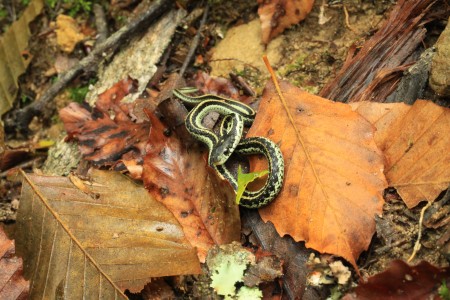


Hi, Lita, all sketches are wonderful and shining!! Best wishes, Sadami